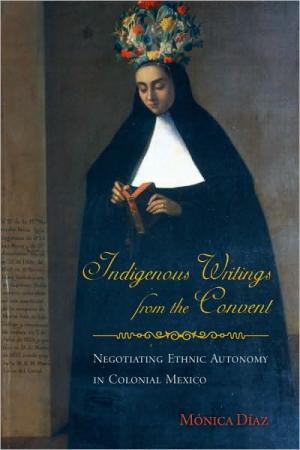Indigenous Writings from the Convent: Negotiating Ethnic Autonomy in Colonial Mexico

After the Spanish invasion of Mexico, the invaders converted the existing noble class of Indians to Catholicism so that the church could regulate the lives of its subjects and help the Spanish colonial administration. The noble class in colonial Mexico had special status and though never equal to the Spanish, they sometimes allied with them against the indigenous people. The nobles wanted to maintain their status and property, they had education and language, and the Spanish wanted to use them as intermediaries to govern the natives. Women lost power and authority under Spanish rule, but noble women tried to maintain their place, at least in the convent.
Many nobles quickly converted to the Catholic religion but women were unable to enter convents except as servants until 1724 when a convent was established specifically for noble indigenous women. Their lives were even more restricted than the Spanish nuns, and their regime in the convent resembles torture more than worship. Monica Diaz, author of Indigenous Writings from the Convent, argues that the women maintained their identity as Indians and nobles by defining themselves in opposition to the Spanish nuns, and when the Indian convent was threatened by allowing Spanish nuns to enter, the noble indigenous women used the tools of language that the colonial system had given them to their advantage.
The author’s stated intent was to focus on the structure of discourse and the agency of the Indian nuns during the battle to keep the convent for Indians. The nobles relied on the colonial focus of “otherness” that had been used to discriminate against them, to argue that the convent should exclude Spanish nuns, a separate but equal argument, but of course they weren’t equal. The argument put the church into a tough spot to claim on the one hand that the Indians were capable of being nuns but on the other hand that they were incapable of running their own convent. The church wanted to minimize the antagonism, because they wanted to continue to control the women and manipulate them as a model minority. Because the church insisted on hierarchy and ethnic difference, the Indian women could use those same arguments to their benefit.
Diaz compared the writings of nuns and priests to show how the priests re-wrote the women’s work and published it without attribution. However, few writings by noble Indians existed so most of the data was from Spanish nuns. A chapter about sermon writing illustrated that when priests talked about Indian nuns, they eliminated any personal history and portrayed their good behavior as a miracle and their main positive attribute as obedience.
Because the noble Indians could write in the style of the oppressor, the author argued that they had agency other indigenous women did not have. According to Diaz, they knew how to create and manipulate alliances, they understood hierarchy and power struggles, and they used this to defend the Indian-only convent. She claims that the elites found a way to maintain their political autonomy by creating a place in the new religious order. The point of the book is that the noble women adapted to new reality but maintained an Indian identity. Since few writings of the noble Indians survived, the sample is quite small and the author’s assumptions and deductions are not fully supported. Whether the actions of the women were positive agency or defensive survival and whether they maintained their Indian heritage is questionable. As with most academic books, one must stumble over the style of writing and use of words.